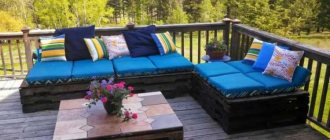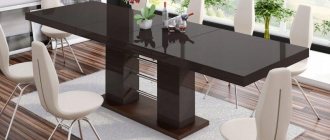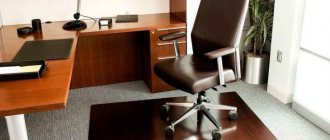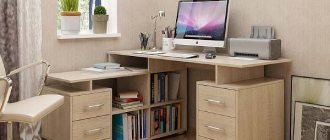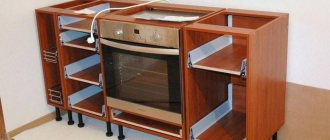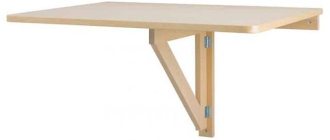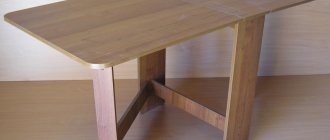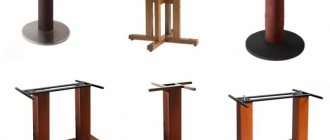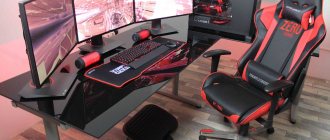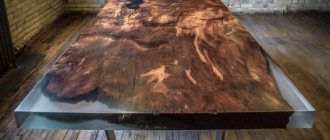Tables are classified:
- by purpose (dining, coffee, writing, special purposes);
- by design (with legs, on a metal base, on side supports, on a stand, with drawers) (Fig. 1);
- in terms of transformability (with hinged lids, sliding, folding, with curtains).
Rice. 1. Types of table designs: 1 – on a metal base; 2 – on side supports; 3 – on legs; 4 – on the rack; 5 – with drawers
The designs of the tables consist of: a lid, a base, transforming devices, and drawers.
When designing, the stability of dining tables can be approximately calculated using the formula:
where P is a vertical load equal to 10 daN (kgf) for tables weighing up to 15 kg and 15 daN for tables weighing over 15 kg;
C – table top overhang, mm;
B – length, width of the table base, mm;
Q – table mass, kg.
Based on the stability of the table, you can determine the maximum permissible overhang of the lid:
If during the calculation it turns out that the stability of the table is insufficient, then it is necessary to reduce the overhang of the table top or increase its mass by using parts of a larger cross-section, greater mass, etc. (Fig. 2).
Rice. 2. Determination of table stability
The table base is the supporting elements of the table. The upper part of the underframe, where the tsars are located, is called the tsar belt. The rigidity of tables is characterized by the ability of the table structure to resist vibration under the influence of external forces. It depends on the rigidity of the connection of the drawers and the fastening of the legs, the correct choice of sections of the legs and drawers of the table. The distance from the floor to the bottom edge of the drawer is at least 610 mm.
The height of the tables depends on their functional purpose, mm:
| Kitchen work table with or without sink, mainly for standing work | 850 |
| Dining table for living rooms | 730 |
| Tables for children depending on age | 430–600 |
| Desks | 720–780 |
| Desks for schoolchildren and teachers | 720–750 |
| Drawing tables | 760 |
| Tables for public places: | |
| for eating while sitting | 730 |
| for drinking while sitting | 680 |
| for eating and drinking while standing | 1 100 |
Some structural elements of table designs
The parts of the underframe are made of coniferous wood and chipboards. Radial drawers are made of plywood or veneer.
Dining tables can be designed as folding, sliding, on wheeled supports, with drawers, pull-out table tops, etc.
Transforming devices for dining tables are divided into walking and rotating.
Running devices are running bars attached to the table top and moved in the grooves of drawers or guide bars, or connected to each other in a rocker rod or with special guides and metal mechanisms.
Rotating devices are rolling pins and screws that are used to secure a rotating lid or insert (Fig. 3).
| Rice. 3. Connecting the parts of the underframe |
Features and dimensions of kitchen tables
No kitchen would be complete without a dining table, which can be of different types. Its design and appearance are significantly influenced by many factors, including the size of the room, design style, and owner preferences.
The main features inherent in this piece of furniture are:
- this is the place in the kitchen where all family members gather to eat;
- all guests invited to the festive feast can comfortably sit behind it;
- if the kitchen is small, it can be used not only as a dining room, but also as a worktop;
- with its help you can equip a free kitchen-dining room or a small kitchenette;
- The folding model is perfect for a kitchen with an area of less than 12 m2.
To find out what size and type of table you need for your kitchen, you need to calculate how many people usually live in your house. According to ergonomic indicators, there should be at least 70 cm of table space per seated person for a person to feel comfortable. If the table in the kitchen is smaller, then everyone at it will be cramped.
When square-shaped dining furniture on one side (at least 70 cm wide) is adjacent to the wall, three people can fit behind it. A round model in the kitchen should have a diameter of more than 90 cm. The width of a rectangular table is usually more than 75 cm.
As a rule, in a small apartment furniture with a width of 60–80 cm is placed. If the kitchen is spacious, any type of table will do.
Side tables
In tables, the supporting structure consists of side posts connected by a transverse bar on which the lid is attached. The supporting part of the racks increases the stability of the table (Fig. 4, 5).
Rice. 4. Options for fastening covers in tables with side supports: 1 – dowels between the side supports and the mounting bars of the cover; 2 – screws between the side supports and the mounting bars of the cover; 3 – dowels and corner tie between the side supports and the mounting bars of the cover; 4 – drawers for dowels; 5 – drawers for dowels and eccentric ties
Rice. 5. Attaching the block to the side supports: 1 – correct location; 2 – incorrect positioning, the table will quickly become loose; 3 – securing the beam with a tie and dowels
Suitable types of kitchen tables for a small kitchen
When choosing furniture for a small kitchen, you need to follow the recommendations of professionals:
- It is necessary to leave a passage at least 60 cm wide between the dining area and the stove. Based on this rule, the table is selected according to the appropriate dimensions.
- The dimensions of the table should be related to the area of the room. If the kitchen is cramped, it is inappropriate to place a wide, massive countertop on thick supports.
- A tablecloth made of thick fabric with hanging edges adds volume to even a small table. To avoid this, do not cover the tabletop or cover it with an openwork light tablecloth or a decorative napkin in light shades.
- With the help of transparent inserts in the table, you can make a small kitchen more spacious, visually expanding the boundaries.
Today, designers have developed various planning solutions for small kitchens. They suggest abandoning classic models in order to save space.
Instead of a table with four legs and a solid tabletop, it is better to buy a model with a rectangular or semi-oval rectangular top. The folding mechanism is fixed to the wall, and the table itself rests on a leg - a spacer.
If a small kitchen is combined with a living room, the traditional model can be replaced with a fashionable bar counter. This table has access from all sides, and it is also used as a work surface.
Tables on a support stand
The base of the rack ends with a cross or is mounted on spacer legs to provide increased stability. Connections between the lid, stand and supports should be chosen to be reliable in order to reduce the possibility of the table tipping over under unilateral loads. Often, for aesthetic reasons and to make the lid more rigid, round tables are equipped with drawers. Racks are most often made of solid wood (Fig. 6).
Rice.
6. Sections of stands for tables: 1, 2, 3 – made of solid wood;
4 – bent-glued veneer hemispheres (glued on dowels) The base of the stand is made in the form of a cross-shaped stand with spacer legs. The spacer legs attached to the sides of the table stand are loosened under the action of the resultant force FF caused by the lateral force FS and the loading force F (Fig. 7), due to which the structure may be destroyed.
Rice. 7. Installation of spacer legs
Design Features
A few words about the color design of the table. It is not always possible to purchase a one-piece set. Designers recommend choosing a table to match the design of the walls or wall facade. For innovative projects and modern styles, contrast with the overall color scheme is acceptable. Typically, ready-made tables offer several colors:
- White models will fit into the Mediterranean style, Provence, loft, shabby chic. The white countertop looks elegant, but requires care; the surface will have to be protected from scratches and stains.
- Tables in brown wood-look shades are traditional; varnished solid wood tabletops are especially appreciated. If necessary, you can restore the worn or damaged surface yourself. Suitable for classic furnishings, country, ethnic, rustic styles.
- Tables in red tones from pastel coral to rich burgundy are chosen by creative people for interiors in oriental style. Light shades are acceptable for kitchen design in Provence, loft, and high-tech styles.
- Green plastic in natural shades has been gaining popularity in recent years. The swamp light green, dark green set creates an atmosphere of peace and tranquility.
- A black table is universal, appropriate in any interior, looks extravagant and solid. Gloss, mirror shine is welcome. For synthetic countertops, materials with inclusions of foil and the addition of bronze or aluminum powder are used.
- Countertops with photo printing create a special flavor in modern interiors. Such models will become the highlight of the design and complement any design project.
Note! Blue tones have been proven to reduce appetite. This design solution will help preserve the figures of the household.
Tables with rope-rail fittings
A sliding rope-rail system for tables using steel cable increases the service life of the finished product by 30% (Fig. 8).
Rice. 8. Rope-rail fittings for tables (the set includes: pin – 8 pcs.; axis of rotation of the middle part of the tabletop – 2 pcs.; support roller for the middle part of the tabletop – 2 pcs.; connecting loop for the middle part of the tabletop – 2 pcs.; table extension mechanism – 2 pcs.)
Form
Depending on the size of the room and the purpose of the table, choose the shape for the piece of furniture. It can be round or oval, square or rectangular. The last option is the most common. Its laconic forms allow it to be installed along the wall, saving space in the room.
Square-shaped tables are designed for small apartments and a small number of people sitting at them. So, only 4 people can sit at a standard square-shaped table. Round and oval shapes also do not imply a large influx of guests. It is best to install them in large rooms.
Sliding tables with running bars
Tables with sliding lids and a non-sliding base are made with a rectangular and round base (round drawer). Figure 9 shows examples of the design of tables with a rectangular base.
Rice. 9. Schematic diagrams of the designs of dining tables with running bars : 1 – T-shaped top; 2 – rectangular with a die; 3 – trapezoidal lateral; 4 – trapezoidal upper with a cracker; 5 – T-shaped side; 6 – rectangular top; 7 – trapezoidal central; 8 – tubular
Recommendations for selection
Selection tips from experts:
- A glass tabletop, although beautiful, is not very useful . Prolonged contact with such material will not add health to the joints of the hands. The glass surface is always cold.
- For a small living room, using a transformer would be a beneficial solution. There are folding, sliding, and even magazine-style models. The main thing is to save precious space.
- You should not choose a table to match the chairs you like . Today it is not necessary to keep everything strictly in one style. You can mix different styles, materials and designs. It is enough that the table fits harmoniously into the overall style of the room.
Tables with hinged lids
Tables with hinged lids are tables with drawer joints, equipped with lids of the same size, freely stacked on top of each other, which can be opened if necessary. At the same time, the useful surface of the table is doubled. In the under-table, between the longitudinal drawers, there is a rotating axle, around which the connected parts of the hinged table cover rotate.
The turning point is determined graphically (Fig. 10). For this purpose, the table is shown in a scale drawing with the lid folded and open in a top view. Straight lines are drawn through the center of the table at point A and through point B (the end of the edge of the table when folded and the junction of the half-lids when unfolded), intersecting at an angle of 45° at point C - the turning point. Hinges are installed on the transverse edges of both covers, allowing the cover to be folded back.
While the top cover, when closed, should have a finish on both sides that matches the finish of the entire table, since both of its surfaces are visible, the bottom surface of the hinged cover should accommodate the socket for the pivot pin, the stop dowel, and the two plates for the locking bolt.
In mass production, marking control templates are used.
Material of manufacture
Similar to styles, stores offer a wide selection of models that differ in the quality of the material. The following types of tables are distinguished:
- made of chipboard (the most affordable type, but it is too fragile and has a short service life);
- made of fiberboard (more expensive than the first type, characterized by increased moisture resistance and resistance to damage);
- made of solid wood (expensive, but beautiful and durable products that can complement any apartment design);
- glass (visually they help expand the space, so they fit well into small kitchens);
- made of stone (high density and durability, made from materials of natural or artificial origin).
A wide variety of models allows you to choose exactly the option that, in terms of functionality and stylistic features, is suitable for a specific room. They choose a table based on the personal preferences of the apartment owners and financial capabilities.
Subscribe to our Social networks
Sliding tables
Sliding tables are rectangular or square tables with drawer joints, the length of the lid can be increased due to retractable half-lids (Fig. 11). Under the top cover on each side there are half-covers. Each half-cover has two guide strips. Thanks to the wedge-shaped shape of the slats, the half-lids can be installed at the level of the table top when pulled out.
Stopping dowels prevent the covers from being pulled out completely. Good functioning of the sliding table is possible with appropriate design and fitting of parts. The cutting and production of individual parts is carried out and controlled using marking templates.
Number of kitchen table legs
Dining furniture can have a different number of legs. Often this parameter is not given much importance. However, this characteristic is just as important as the material or size.
Let's consider how many legs dining furniture can have and what are the advantages of each option:
- One support in the center. This model is comfortable and stable. In addition, it is comfortable to sit at the table, since nothing interferes with your legs.
- A product with two legs, despite the fact that it visually looks compact and cozy, is not the most comfortable. A significant disadvantage of this design is that there is nowhere to put your feet if you sit at the ends.
- Furniture with three legs is usually round in shape. These models are comfortable, functional and aesthetically pleasing.
- A table with four legs is the classic, most popular option, the convenience of which is unnecessary to talk about.
Kitchen furniture makers often experiment with the design of support elements. Products with chrome-plated metal legs, which can be massive or light, curved, reminiscent of the legs of a huge insect, or straight, fit perfectly into fashionable interiors made in minimalist, hi-tech, and classic styles.
If the tabletop is made of transparent durable glass, the legs shining with a metallic sheen will become a bright artistic accent.
Forged metal legs always look great, realizing the most daring ideas of designers. The structures are as stable as possible, versatile, practical and easy to maintain. Regardless of the stylistic design of the interior, forged elements will always fit organically into it.
Folding tables
Tables with round lids in the form of an ellipse and with rounded corners of the lids are designed as folding tables to increase the working surface. In this case, the top cover is made of separate elements that can be moved apart in different directions. The inserted parts of the lid, stored in the underframe, are inserted into the resulting space.
Rice. 10. Calculation of the axis of rotation for tables with hinged lids: 1 – hole for the latch; 2 – fixing dowel; 3 – clamp; 4 – underframe; 5 – locking block; 6 – hinge for moving the table (A, B, C – radii of rotation and center of rotation)
Rice. 11. Design of the sliding table: 1 – the lid is retracted; 2 – the cover is extended; 3 – locking pin; 4 – underframe; 5 – retractable bar; 6 – underframe; 7 – guide bar
Structural strips are attached to the bottom of both halves of the lids. Samples are provided in the tsars. The unfoldable covers are connected to each other by hinges and mounted on a cylindrical rod. Structural details and calculation of the axis rotation point are shown in Figure 12.
| Rice. 12. Design of a round sliding table: K1 – tab; R – round bar; K0 – consoles; A – locking blocks; V – connecting strips for fastening R; F – guide strips; Z – stretchable strips; D – cover diameter |
The size of the folded-out table inserts is determined by the size of the drawer. When folded, the size of the inserts should be equal to half the diameter of the lid or half the width of the lid.
Desks
Desk desks can be single- or double-pedestal, as well as with drawers. The designs of the tables consist of a lid, an underframe, a back panel (apron), and a cabinet. The minimum dimensions of the cover of desks with cabinets in length and width are: double-pedestal - 1,400 × 700 mm, single-pedestal - 1,000 × 600 mm.
The dimensions of the boxes are regulated by the dimensions of the items for which the boxes are intended and the methods of storing them. In desks with drawers located directly under the lid, the overhang of the lid relative to the front wall of the drawer should be minimal for a better view of the contents of the drawer (Fig. 13).
Rice. 13. Single-pedestal desk: 1 – table cover; 2 – supporting element; 3 – rear panel, apron; 4 – cabinet; 5 – box; 6 – general view of the box; 7 – installation of additional fastening (bar) for wide drawers; 8 – handle installation
It is very important that the thickness of the tabletop is no thinner than 22 mm when using chipboard, otherwise the table will not pass strength tests.
How to choose a computer desk
In the modern world it is difficult to live without a computer. People who spend a lot of time on a device need to feel comfortable, which is why they need to purchase a special computer desk. There are three types of computer desks: straight, corner and U-shaped.
- A straight computer desk is a classic option that is used most often. Such designs have a special shelf for the keyboard and a stand for the monitor.
- The corner design saves usable space. You can place many items needed for work on it.
- A U-shaped table is the most convenient option.
To choose a suitable table, you need to consider:
- size of the structure;
- availability and quality of fittings;
- what material is the table made of?
- service life.
